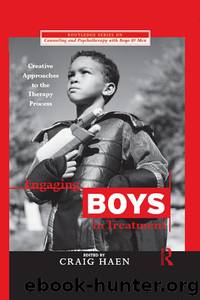Engaging Boys in Treatment by Haen Craig;

Author:Haen, Craig;
Language: eng
Format: epub
Publisher: Taylor & Francis Group
SUPERHEROES
Most stories, myths, plays, and films contain some form of a hero character. Superheroes, though, are a breed apart and have specific characteristics that are well known. Rovin (1985) summarized the qualities of the superhero, but points out that some of the most popular characters represent exceptions to these rules:
In the realm of superheroes, these factors are usually true: superheroes have at least one superpower, whether physical or attributable to a weapon, instrument or conveyance; they work actively and magnanimously for the common good; their values are neither vindictive nor selfish; they tend to operate on earth, though they may not be from this world; they achieve anonymity by assuming a mortal identity or alter ego; and they wear a distinctive costume. (p. xi)
The superhero character has its roots in mythology and ancient drama, and like the tragic hero, many early superheroes had a noble birth and then were cast out by their families or set out to pursue a quest (Haen & Brannon, 2002). Just as modern drama evolved from focusing on the tragic figure with noble origins to focusing on the common man, most modern superhero stories focus on ordinary men who become extraordinary heroes. However, as Rubin (2007) pointed out, âUnlike the classical hero, the modern superhero never fully integrates back into society and is continually confronted with irreconcilable tensions both within him or herself or the societyâ (p. 8).
At the most basic level, superhero roles appeal to boys because they are empowering. These roles can be effective in the beginning stages of the therapeutic process by providing âan opening into the landscape of alternative perceptions, directly challenging a subscribed view of passivity and fearfulnessâ (Archer, 1997, p. 77). By invoking the superhero role in fantasy play, the child begins to gain ideals and inspiration for future development (Pecora, 1992).
This was certainly true for one nine-year-old client of mine. Matt had spent his life coping with a host of challenges, including a degenerative muscle disorder that ensured he walked with braces and spent much of his time in physical therapy. He had several co-occurring medical conditions that impaired his cognitive functioning, memory, and academic performance. Not surprisingly, Matt was enamored with superhero stories, and had a particular fascination with Cartoon Network's Ben 10 character. In this series, a boy named Ben Tennyson discovers an alien pod while on a camping trip with his family. Inside it is a watch called the Omnitrix that permanently fuses to his wrist, giving him the ability to change into a variety of alien life forms, each with particular powers. For Matt, a character who has an ability to morph into different body types in order to be competent in situations had an obvious appeal and provided a framework for our treatment, as we began to work on his frustrations about his limitations and on bolstering his self-esteem.
Child therapists have found that, regardless of disability, social standing, or circumstance, clients can feel empowered within the space of dramatic and fantasy play (Bouzoukis, 2001; Crenshaw & Mordock, 2005; Haen, 2008).
Download
This site does not store any files on its server. We only index and link to content provided by other sites. Please contact the content providers to delete copyright contents if any and email us, we'll remove relevant links or contents immediately.
Unwinding Anxiety by Judson Brewer(72055)
The Art of Coaching by Elena Aguilar(52240)
The Fast Metabolism Diet Cookbook by Haylie Pomroy(20929)
Rewire Your Anxious Brain by Catherine M. Pittman(18336)
Healthy Aging For Dummies by Brent Agin & Sharon Perkins RN(16933)
Talking to Strangers by Malcolm Gladwell(12912)
The Art of Thinking Clearly by Rolf Dobelli(9951)
Crazy Rich Asians by Kevin Kwan(8912)
Mindhunter: Inside the FBI's Elite Serial Crime Unit by John E. Douglas & Mark Olshaker(8748)
The Compound Effect by Darren Hardy(8541)
Periodization Training for Sports by Tudor Bompa(7939)
Becoming Supernatural by Dr. Joe Dispenza(7864)
Tools of Titans by Timothy Ferriss(7848)
Wonder by R. J. Palacio(7755)
Crystal Healing for Women by Mariah K. Lyons(7733)
Bodyweight Strength Training by Jay Cardiello(7686)
Therapeutic Modalities for Musculoskeletal Injuries, 4E by Craig R. Denegar & Ethan Saliba & Susan Saliba(7605)
Should I Stay or Should I Go? by Ramani Durvasula(7439)
Change Your Questions, Change Your Life by Marilee Adams(7399)
